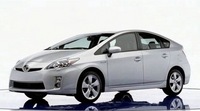2010 Toyota Prius Review
 2010 TOYOTA PRIUS |
SEE ALSO: Compare Toytota Prius to Ford Fusion Hybrid, Honda Insight Hybrid, Nissan Altima Hybrid
SEE ALSO:Toyota Specs, Reviews and Comparisons-Toyota Buyers Guide
THE AUTO PAGE
By
John Heilig
SPECIFICATIONS: 2010 TOYOTA PRIUS
Model: 2010 Toyota PriusEngine: 1.8-liter Atkinson cycle I4plus 27 kw electric motor
Horsepower/Torque: 98 hp @ 5200 rpm/105 lb.-ft. @ 4000 rpm (134 total h orsepower)
Transmission: Electronic CVT
Wheelbase: 106.3 in.
Length/Width/Height: 175.6 x 68.7 x 58.7 in.
Tires: P215/45R17
Cargo volume: 15.6/21.5/39.6 cu. ft. (under tonneau/to glass/rear seats down)
Fuel economy: 51 mpg city/48 mpg highway/65 mpg test (see text)
Fuel capacity: .11.9 gal.
Sticker: $21,000 (Prius I starting base) - $27,270 (Prius V starting base) plus $750 delivery charge
The Bottom Line: The new Prius is bigger than its predecessor, but not by much. It is more economical though, even with a bigger engine. You have to look hard to notice the subtle changes in styling, but they are there. The new model overcomes some of the deficiencies of the older one, which is one of the reasons for a redesign.
When you have a buyer base as loyal as that of the Toyota Prius hybrid, you don’t want to get too carried away when you do a redesign. The retention rate with Prius is in the 85-90 percent range. Therefore, the 2010 third generation Prius looks a lot like the second-generation Prius. The wheelbase is the same, the overall length is a half inch longer, and it’s three quarters of an inch wider. There’s a subtle rise to the roof that “moves” from just behind the driver’s head to a bit further back. And that’s it. 0A
The changes under the hood are relatively minor as well. The four-cylinder Atkinson cycle gasoline engine has been enlarged to 1.8 liters from 1.5 liters and develops 22 more horsepower to 98. The electric side of the hybrid is upgraded as well, to 27 kw vs. 25, from a 201.6 volt NiMH battery that is more compact. The end result is slightly better performance on the road with the added benefit of better fuel economy.
Toyota quotes 50 mpg city and 49 mpg highway with the new Prius, vs. 48/45 with the previous generation. In our short test run we did average 65 mpg, but that was by driving slowly and using the battery as much as possible.
There are three driving modes with the Prius – EV, which is completely electric and will power the car for one mile at 25 mph; ECO, for “economy” and smoothes out the throttle openings; and PWR, which adds sportiness for hills and Interstate merges.
Inside, the center stack design is reminiscent of the Lexus RX and seems to follow a Toyota corporate design. There’s a multi-information display at the top center of the dash that has the speedometer and all information. My co-driver and I felt there was too much information from this display. Personally, I would have preferred a speedometer and turn signal readout closer to the driver and more in the line of sight, although the display is canted toward the driver. The center stack has flat panel switches which are clean and neat.
The shifter has a unique pattern, with R,N and D on the left and B on the right. It has pushbutton start and stop, with the park brake engaged through a button on the dash.
Prius also has an available solar roof whose only purpose is to run the fan in the ventilation system. It seems as if it could have another function. There’s also an available sun roof. The key fob can remotely turn on the air conditioning system, which will run for about three minutes cooling the car before you get in.
Also available is Toyota’s Safety Connect, which is similar to OnStar. Through Safety Connect you have collision notification and response, recovery of your Prius if it’s stolen, emergency assistance and roadside assistance. Other features include Dynamic Radar Cruise Control, Lane Departure Warning and Lane Keep Assist (similar to LDW).
In our test ride we noticed some tire noise in the electric mode, indicating that the electric mode was too quiet.
There’s a bar across the rear window that breaks up rearward vision, similar to the Honda Civic of a few years back. General ride quality is very good with good front and rear legroom. One reason for moving the roof peak rearward is to increase rear headroom, and it works. Cornering ability is good on exit ramps, but you don’t buy a Prius for its cornering ability.
Prius has a nice cargo area that is carpeted and includes good underfloor storage.
The third generation Prius isn’t going to shock anyone with its design or performance. It is going to satisfy current Prius owners who may want to move up, as well as new-to-the-brand buyers who’d be interested in a hybrid.
© 2009 The Auto Page Syndicate


